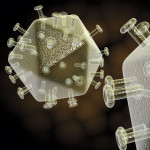Gilead Sciences’ investigational integrase strand transfer inhibitor (ISTI) bictegravir (GS-9883) appears to have a resistance profile superior to currently available drugs in its class of antiretrovirals. Researchers from Gilead presented findings from four preclinical and Phase I studies of bictegravir at the American Society of Microbiology (ASM) Microbe 2016 Conference in Boston.
The studies looked at the antiviral potency, resistance profile, pharmacokinetics (how the body metabolizes the drug) and safety of bictegravir. The drug is also being studied in Phase III trials as a component of a single-tablet HIV regimen also containing tenofovir alafenamide (TAF) and Emtriva (emtricitabine).
In one laboratory study of bictegravir, researchers pitted the drug against other ISTIs, comparing how they responded to various HIV strains with mutations conferring resistance to that class of drugs. They found that the drug demonstrated an improved resistance profile compared with Tivicay (dolutegravir) and a markedly improved resistance profile compared with Vitekta (elvitegravir) and Isentress (raltegravir).
Another lab study showed that bictegravir was a potent INSTI. The drug appeared to be metabolized by the body more effectively and had an improved resistance profile compared with Tivicay, Vitekta and Isentress, which constitute all the currently approved INSTIs. Signs also indicate that bictegravir will put people with HIV at low risk of drug-drug interactions.
In a Phase I study, 20 adults living with HIV received 5, 25, 50 or 100 milligrams of bictegravir or placebo once daily for 10 days. The researchers found that the drug was well tolerated at every dose level and rapidly reduced viral load, commensurate with the dose level, sustaining the reduction throughout treatment. None in the study developed primary resistance mutations to ISTIs, nor did they report serious adverse health events or stop the drug because of such events.
Another laboratory study analyzed bictegravir’s activity against HIV both alone and combined with TAF, Emtriva and Prezista (darunavir). By itself, bictegravir proved highly potent against HIV while demonstrating no antiviral effect against other viruses. When combined with the other three ARVs, bictegravir was synergistic in targeting HIV. The drug also had a low level of toxicity to human cells that are not a target of ARVs.
To read a press release on the studies, click here.







1 Comment
1 Comment